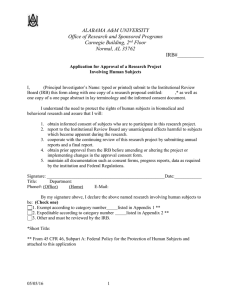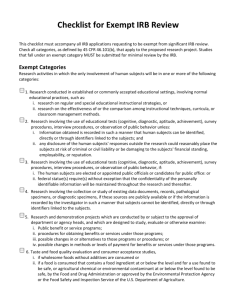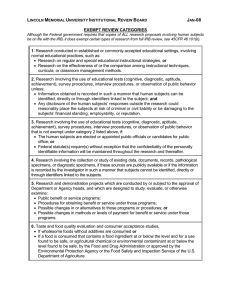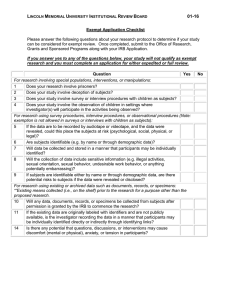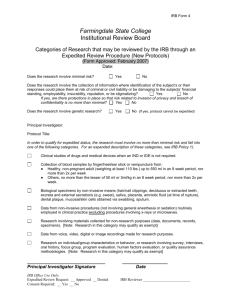ALABAMA A&M UNIVERSITY Office of Research and Sponsored Programs Carnegie Building, 2 Floor
advertisement
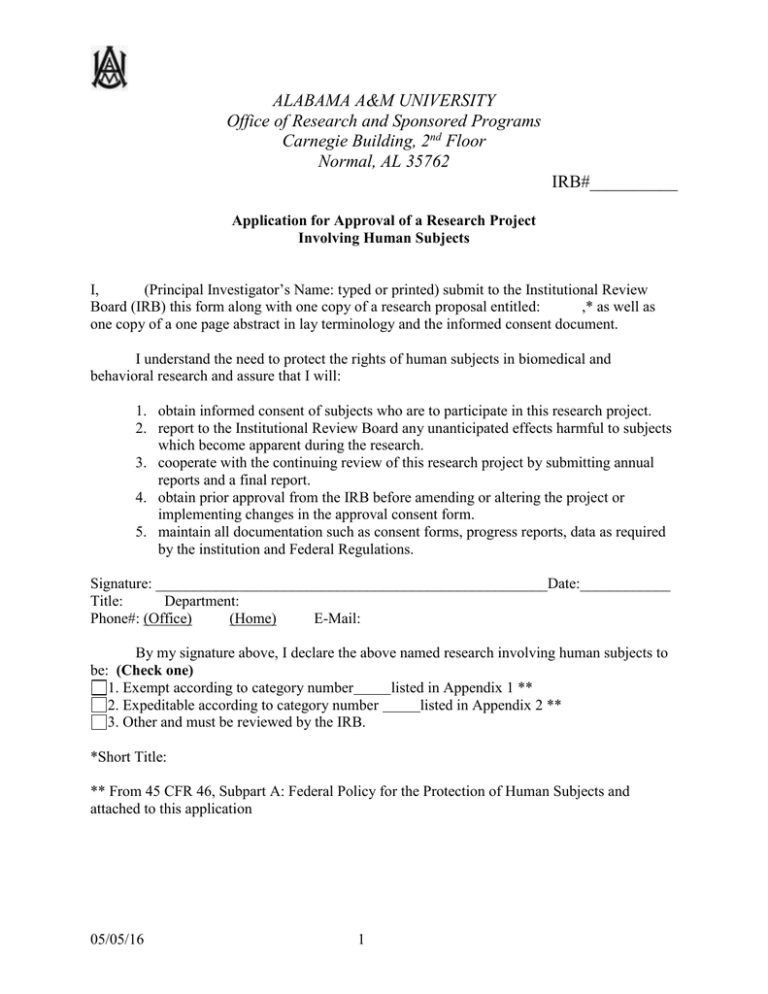
ALABAMA A&M UNIVERSITY Office of Research and Sponsored Programs Carnegie Building, 2nd Floor Normal, AL 35762 IRB#__________ Application for Approval of a Research Project Involving Human Subjects I, (Principal Investigator’s Name: typed or printed) submit to the Institutional Review Board (IRB) this form along with one copy of a research proposal entitled: ,* as well as one copy of a one page abstract in lay terminology and the informed consent document. I understand the need to protect the rights of human subjects in biomedical and behavioral research and assure that I will: 1. obtain informed consent of subjects who are to participate in this research project. 2. report to the Institutional Review Board any unanticipated effects harmful to subjects which become apparent during the research. 3. cooperate with the continuing review of this research project by submitting annual reports and a final report. 4. obtain prior approval from the IRB before amending or altering the project or implementing changes in the approval consent form. 5. maintain all documentation such as consent forms, progress reports, data as required by the institution and Federal Regulations. Signature: ____________________________________________________Date:____________ Title: Department: Phone#: (Office) (Home) E-Mail: By my signature above, I declare the above named research involving human subjects to be: (Check one) 1. Exempt according to category number listed in Appendix 1 ** 2. Expeditable according to category number listed in Appendix 2 ** 3. Other and must be reviewed by the IRB. *Short Title: ** From 45 CFR 46, Subpart A: Federal Policy for the Protection of Human Subjects and attached to this application 05/05/16 1 Funding Source: (if applicable) Purpose of the Study: Questions or Hypotheses: Description of the Subjects (Include # of Controls): Description of Procedure: Instrumentation (Brief Description or Attachment): Duration of the Study: a. Total Amount of Time with each Subject: b. Time to Complete the Study: Benefit(s) of the Study: Possible Risks to the Subjects and the Precaution Taken to Avoid the Risks (Monitoring): Confidentiality / Anonymity 05/05/16 2 *Criteria for IRB approval of research: risks to subjects are minimized; risks are reasonable in relation to anticipated benefits; selection of subjects is equitable; informed consent is sought from each subject; informed consent is appropriately documented. Institutional Action: IRB Review: ____ Exempt ____ Expedited ____ Full ____ Application Approved.* ____ Application denied at this time. Additional information requested and consists of the following: ____ Application denied Signature: ___________________________________ IRB Chair 05/05/16 _____________ Date 3 (For Student Research IRB Application Only) I, the researcher’s Chairman, have reviewed the research proposal and agree with the declaration above and understand that, if the proposal research is declared to be exempt, my signature here under represents approval for the researcher to commence with the research. ** **(Always required) (Signature) (Name and Title) (Dept and School) NB: In all circumstances, the Chairman must keep one copy of everything and must forward the Application Form with original signatures and the remaining two copies to the Office of Research Sponsored Programs, Carnegie Building, 2nd Floor. Also, in exempt cases, the Chairman must give the researcher a copy of the signed application form, authorizing the research to begin. 05/05/16 4 45 CFR 46, Subpart A: Federal Policy for the Protection of Human Subjects (Basic DHHS Policy for Protection of Human Research Subject) 6/18/91. APPENDIX 1 RESEARCH ACTIVITIES THAT MAY BE EXEMPT FROM IRB REVIEW AND APPROVAL Research Activities in which the only involvement of human subjects will be in one or more of the following categories are exempt from this policy: (1) Research conducted in established or commonly accepted educational setting, involving normal education practices, such as: (i) (ii) (2) Research involving the use of educational tests (cognitive, diagnostic, aptitude, achievement), survey procedures, interview procedures or observation of public behavior, unless: (i) (ii) (3) research or regular and special education instructional strategies research on the effectiveness of/or the comparison among instructional techniques, curricular, or classroom management methods. information obtained is recorded in such a manner that human subjects can be identified, directly or through identifiers linked to the subjects any disclosure of the human subjects’ responses outside the research could reasonably place the subjects at risk of criminal or civil liability or be damaging to the subjects’ financial standing, employability, or reputation. Research involving the use of educational tests (cognitive, diagnostic, aptitude, achievement), survey procedures, interview procedures or observation of public behavior that is not exempt under paragraph (b) (2) of this section, if: (i) (ii) the human subjects are elected or appointed public officials or candidates for public office federal statute(s) require(s) without exception that the confidentiality of the personally identifiable information will be maintained throughout the research and thereafter. (4) Research involving the collection or study of existing data, documents, records, pathological specimens, or diagnostic specimens, if these sources are publicly available or if the information is recorded by the investigator in such a manner that subjects cannot be identified, directly or through identifiers linked to the subjects. (5) Research and demonstration projects which are conducted by/or subject to the approval of department or agency heads, and which are designed to study, evaluate, or otherwise examine: (i) (ii) (iii) (iv) (6) public benefit or service programs procedures for obtaining benefits or services under those programs possible changes in or alternatives to those programs or procedures possible changes in methods or levels of payment or levels of payment for benefits or services under those programs Taste and food quality evaluation and consumer acceptance studies, (i) if wholesome foods without additives are consumed (ii) if a food is consumed that contains a food ingredient at or below the level and for a use found to be safe, or agricultural chemical or environmental contaminated at or below the level found to be safe, by the Food and Drug Administration or approved by the Environmental Protection Agency or the Food Safety and Inspection Service of the U.S. Department of Agriculture. 10/15/08 5 45 CFR 46, Subpart A: Federal Policy for the Protection of Human Subjects (Basic DHHS Policy for Protection of Human Research Subject) 6/18/91. APPENDIX 2 RESEARCH ACTIVITIES THAT MAY BE REVIEWED THROUGH EXPEDITED REVIEW PROCEDURES Research activities involving no more that minimal risk and in which the only involvement of human subjects will be in one or more of the following categories (carried out through standard methods) may be reviewed by the Institutional Review Board through the expedited review procedure authorized in 46.110 of 45 CFR Part 46. (1) Collection of hair and nail clippings, in a nondisfiguring manner; deciduous teeth; and permanent teeth if patient care indicated a need for extraction. (2) Collection of excreta and external secretions including sweat, uncannulated saliva, placenta removed at delivery, and amniotic fluid at the time of rupture of the membrane prior to or during labor. (3) Recording of data from subjects 18 years of age or older using noninvasive procedures routinely employed in clinical practice. This includes the use of physical sensors that are applied either to the surface of the body or at a distance and do not involve input of manner or significant amounts of energy into the subject or an invasion of the subject’s privacy. It also includes such procedures as weighing, testing sensory acuity, electrocardiography, electroencephalography, thermography, detection of naturally occurring radioactivity, diagnostic echography, and electroretinography. It does not include exposure to electromagnetic radiation outside the visible range (for example, xrays, microwaves). (4) Collection of blood samples by venipuncture, in amounts not exceeding 450 milliliters in an eight-week period and no more often than two times per week, form subjects 18 years of age or older and who are in good health and not pregnant. (5) Collection of both supra- and subgingival dental plaque and calculus, provided the procedure is not more invasive than routine prophylactic scaling of the teeth and process is accomplished in accordance with accepted prophylactic techniques. (6) Voice recordings made for research purpose such as investigations of speech defects. (7) Moderate exercise by healthy volunteers. (8) The study of existing data, documents, records, pathological specimens, or diagnostic specimens. (9) Research on individual or group behavior or characteristics of individuals, such as studies of perception, cognition, game theory, or test development, where the investigator does not manipulate subjects’ behavior and the research will not involve stress to subjects. (10) Research on drugs or devices for which an investigational new drug exemption is not required. 10/15/08 6
